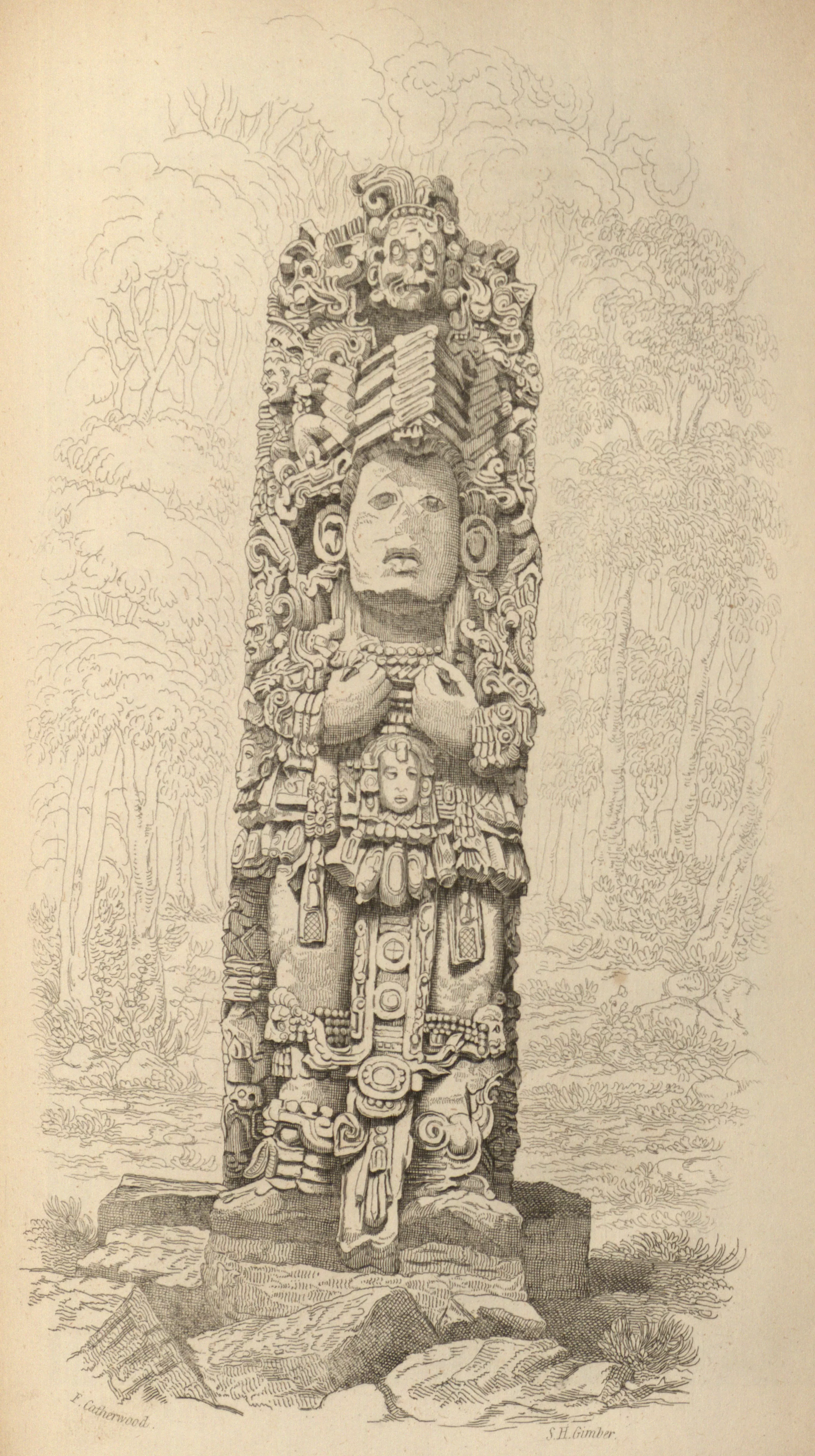Creation Date
1841
Height
20 cm
Width
11 cm
Medium
Genre
Description
This image—rendered using a camera lucida—depicts a monument from the pre-Columbian Maya city, Xukpi, now known as Copán.
A large stone stela, facing forward, depicts a Maya deity decorated with myriad visual embellishments, its fists clenched upon its chest. The background depicts the small clearing in which the stela now stands, fading back into a thick forest.
John Lloyd Stephens and Frederick Catherwood arrived in Copán on November, 13, 1839 (Bourbon 114), and immediately purchased the city for fifty dollars (Bourbon 114; Evans 54). Stephens then traveled to Guatemala City to fulfill his diplomatic obligations as ambassador to Central America, while Catherwood remained in Copán to clear brush from the city and to begin work on drawing its buildings and monuments. Stephens had originally planned to transport the city’s artifacts, and even some of its buildings, down the Copán River and eventually to a permanent exhibition in New York, but this was impossible given the speed of the river’s rapids (Bourbon 119).
Catherwood’s Stone Idol, front view and a number of his other illustrations (reproduced in Incidents of Travel in Central America, Chiapas, and Yucatán) constitute the first systematic attempt at a realistic representation of Mexican antiquities, as well as the first time a camera lucida had been used draw such ruins. According to Stephens's account of their expedition, Catherwood turned to the camera lucida when the designs on the Mayan artifacts proved too complex for the naked eye and too intricate to replicate by hand (Evans 53; Stephens, Central America 120). Consequently, Catherwood’s drawings blend Enlightenment notions of faithful, scientific representations with nascent, Romantic-era visual technologies (Evans 53).
Catherwood’s illustrations of particular objects, such as Stone Idol, front view, serve a dual function. First, they accurately illustrate the size, proportion, and visual decoration of ancient Maya objects, data which was important to potential collectors of Maya artifacts, museum exhibitors, and investors in future expeditions to the region. Secondly, many of the artifacts Catherwood drew were being seen in the United States and Europe for the first time, and, as such, the assurance of their accurate portrayal was of paramount importance to the viewer. This concern was particularly important for Catherwood, who made use of a camera lucida in his rendering of Maya artifacts like this one.
The Federal Republic of Central America was formed by the union of El Salvador, Guatemala (which included much of the modern Mexican state of Chiapas), Nicaragua, Honduras, and Costa Rica; the Republic had its capital at Guatemala City. Following the entity’s collective independence from Spain in 1821, the Republic was established in 1823 as a federal representative republic, modeled after the United States. Though a sovereign republic, the country had been annexed by Mexico upon its independence, creating a political battle between liberals (wishing to be part of the progressive Mexican state) and conservatives (loyal to the Republic’s autonomy). Due to his diplomatic experience, John Lloyd Stephens had been appointed Special Ambassador to Central America by President Martin van Buren; however, due to this political civil war, the country was essentially a defunct entity by his and Catherwood's arrival in 1838. This lack of diplomatic obligations allowed Stephens and Catherwood to further concentrate on their archaeological survey. By 1840 four of the five states in the union had declared independence, legally dissolving the country.
Locations Description
Copán is the modern name for a pre-Columbian Mayan city, now a UNESCO World Heritage Site, originally called Xukpi (5th-9th century AD). It is in the Copán Department of western Honduras, near the border with Guatemala.
Publisher
Harper and Brothers
Collection
Accession Number
F 1432 S883 1841 Vol. 1
Additional Information
Bibliography
Bourbon, Fabio. The Lost Cities of the Mayas: The Life, Art, and Discoveries of Frederick Catherwood. New York: Abbeville P, 2000. Print.
Catherwood, Frederick. Views of Ancient Monuments in Central America, Chiapas and Yucatan. Barre: Barre, 1965. Print.
Evans, R. Tripp. Romancing the Maya: Mexican Antiquity in the American Imagination, 1820-1915. Austin: U of Texas P, 2004. Print.
Stephens, John Lloyd. Incidents of Travel in Central America, Chiapas, and Yucatan. Vol. 1. New York: Harper, 1841. Print. 2 vols.
Stephens, John Lloyd. Incidents of Travel in Yucatan. New York,: Harper, 1843. Print.
Von Hagen, Victor Wolfgang. F. Catherwood, Architect-Explorer of Two Worlds. Barre: Barre, 1968. Print.

